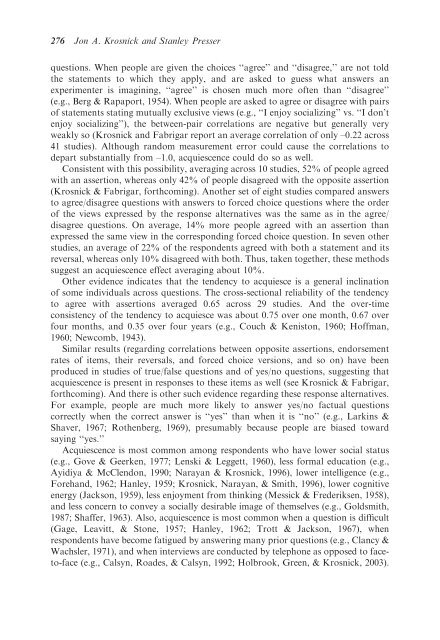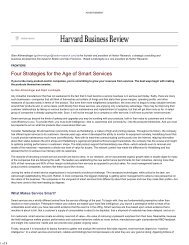Question and Questionnaire Design - Stanford University
Question and Questionnaire Design - Stanford University
Question and Questionnaire Design - Stanford University
Create successful ePaper yourself
Turn your PDF publications into a flip-book with our unique Google optimized e-Paper software.
276 Jon A. Krosnick <strong>and</strong> Stanley Presserquestions. When people are given the choices ‘‘agree’’ <strong>and</strong> ‘‘disagree,’’ are not toldthe statements to which they apply, <strong>and</strong> are asked to guess what answers anexperimenter is imagining, ‘‘agree’’ is chosen much more often than ‘‘disagree’’(e.g., Berg & Rapaport, 1954). When people are asked to agree or disagree with pairsof statements stating mutually exclusive views (e.g., ‘‘I enjoy socializing’’ vs. ‘‘I don’tenjoy socializing’’), the between-pair correlations are negative but generally veryweakly so (Krosnick <strong>and</strong> Fabrigar report an average correlation of only –0.22 across41 studies). Although r<strong>and</strong>om measurement error could cause the correlations todepart substantially from –1.0, acquiescence could do so as well.Consistent with this possibility, averaging across 10 studies, 52% of people agreedwith an assertion, whereas only 42% of people disagreed with the opposite assertion(Krosnick & Fabrigar, forthcoming). Another set of eight studies compared answersto agree/disagree questions with answers to forced choice questions where the orderof the views expressed by the response alternatives was the same as in the agree/disagree questions. On average, 14% more people agreed with an assertion thanexpressed the same view in the corresponding forced choice question. In seven otherstudies, an average of 22% of the respondents agreed with both a statement <strong>and</strong> itsreversal, whereas only 10% disagreed with both. Thus, taken together, these methodssuggest an acquiescence effect averaging about 10%.Other evidence indicates that the tendency to acquiesce is a general inclinationof some individuals across questions. The cross-sectional reliability of the tendencyto agree with assertions averaged 0.65 across 29 studies. And the over-timeconsistency of the tendency to acquiesce was about 0.75 over one month, 0.67 overfour months, <strong>and</strong> 0.35 over four years (e.g., Couch & Keniston, 1960; Hoffman,1960; Newcomb, 1943).Similar results (regarding correlations between opposite assertions, endorsementrates of items, their reversals, <strong>and</strong> forced choice versions, <strong>and</strong> so on) have beenproduced in studies of true/false questions <strong>and</strong> of yes/no questions, suggesting thatacquiescence is present in responses to these items as well (see Krosnick & Fabrigar,forthcoming). And there is other such evidence regarding these response alternatives.For example, people are much more likely to answer yes/no factual questionscorrectly when the correct answer is ‘‘yes’’ than when it is ‘‘no’’ (e.g., Larkins &Shaver, 1967; Rothenberg, 1969), presumably because people are biased towardsaying ‘‘yes.’’Acquiescence is most common among respondents who have lower social status(e.g., Gove & Geerken, 1977; Lenski & Leggett, 1960), less formal education (e.g.,Ayidiya & McClendon, 1990; Narayan & Krosnick, 1996), lower intelligence (e.g.,Foreh<strong>and</strong>, 1962; Hanley, 1959; Krosnick, Narayan, & Smith, 1996), lower cognitiveenergy (Jackson, 1959), less enjoyment from thinking (Messick & Frederiksen, 1958),<strong>and</strong> less concern to convey a socially desirable image of themselves (e.g., Goldsmith,1987; Shaffer, 1963). Also, acquiescence is most common when a question is difficult(Gage, Leavitt, & Stone, 1957; Hanley, 1962; Trott & Jackson, 1967), whenrespondents have become fatigued by answering many prior questions (e.g., Clancy &Wachsler, 1971), <strong>and</strong> when interviews are conducted by telephone as opposed to faceto-face(e.g., Calsyn, Roades, & Calsyn, 1992; Holbrook, Green, & Krosnick, 2003).
















